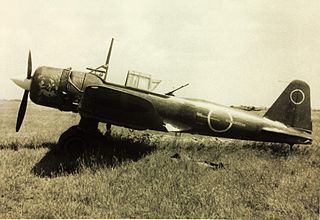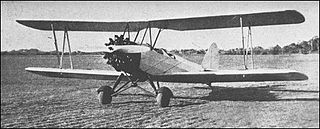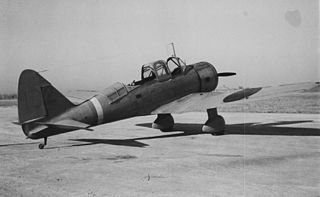
The Nakajima Ki-115 Tsurugi is a one-man kamikaze aircraft that was developed by the Imperial Japanese Army Air Force during the closing stages of World War II in 1945. The Imperial Japanese Navy called this aircraft Tōka.

The Mitsubishi Ki-46 was a twin-engine reconnaissance aircraft that was used by the Imperial Japanese Army in World War II. Its Army Shiki designation was Type 100 Command Reconnaissance Aircraft (一〇〇式司令部偵察機); the Allied brevity code name was "Dinah".

The Yokosuka R2Y Keiun was a prototype reconnaissance aircraft built in Japan late in World War II.

The Mitsubishi Ki-57 was a Japanese passenger transport aircraft, developed from the Ki-21 bomber, during the early 1940s.

The Mitsubishi Ki-51 was a light bomber/dive bomber in service with the Imperial Japanese Army during World War II. It first flew in mid-1939. Initially deployed against Chinese forces, it proved to be too slow to hold up against the fighter aircraft of the other Allied powers. However, it performed a useful ground-attack role in the China-Burma-India theater, notably from airfields too rough for many other aircraft. As the War drew to a close, the Japanese began using them in kamikaze attacks. Total production was around 2,385.

The Tachikawa Ki-17 was a basic training aircraft of the Imperial Japanese Army Air Force built by Tachikawa Aircraft Company Ltd in the 1930s. It was known to the Allies under the nickname of Cedar during World War II.

The Tachikawa Ki-94 was a single-seat fighter-interceptor aircraft project undertaken by the Tachikawa Aircraft Company and to be operated by the Imperial Japanese Army. The project refers to two aircraft designs: the Ki-94-I and the Ki-94-II, both of which did not advance beyond the mock-up and prototype stage respectively.

The Tachikawa Ki-36 was a Japanese army co-operation aircraft of World War II. It was a two-seat, low-wing monoplane with a single piston engine and fixed, tailwheel-type undercarriage.

The Tachikawa Ki-55 was a Japanese advanced trainer.

The Kawasaki Ki-96 was a Japanese single seat, twin-engine heavy fighter of World War II. It was intended to replace the Kawasaki Ki-45s of the Imperial Japanese Army Air Service. However, it was not adopted, and only three prototypes were built.

The Tachikawa Ki-74 was a Japanese experimental long-range reconnaissance bomber of World War II. A twin-engine, mid-wing monoplane, it was developed for the Imperial Japanese Army Air Service but never deployed in combat. The Ki-74 was designed for high altitude operation with a pressurized cabin for its crew.

The Nakajima Ki-49Donryu was a twin-engine Japanese World War II heavy bomber. It was designed to carry out daylight bombing missions, without the protection of escort fighters. Consequently, while its official designation, Army Type 100 Heavy Bomber, was accurate in regard to its formidable defensive armament and armor, these features restricted the Ki-49 to payloads comparable to those of lighter medium bombers – the initial production variant could carry only 1,000 kg (2,200 lb) of bombs.

The Mitsubishi Ki-30 was a Japanese light bomber of World War II. It was a single-engine, mid-wing, cantilever monoplane of stressed-skin construction with a fixed tailwheel undercarriage and a long transparent cockpit canopy. The type had significance in being the first Japanese aircraft to be powered by a modern two-row radial engine. During the war, it was known by the Allies by the name Ann. It was mistakenly identified by the British as the Mitsubishi Army 97 Ann.

The Mitsubishi Ki-15Army Type 97 Command Reconnaissance aircraft was a Japanese reconnaissance aircraft and a light attack bomber of the Second Sino-Japanese War and Pacific War. It began as a fast civilian mail-plane. It was a single-engine, low-wing, cantilever monoplane with a fixed tailwheel undercarriage; it carried a crew of two. It served with both the Imperial Japanese Army and Navy. During World War II it was code-named "Babs" by the Allies.

The Kokusai Ku-7 Manazuru was a large experimental twin boom Japanese military glider.

The Mitsubishi Ki-83 (キ83) was a Japanese experimental long range heavy fighter designed near the end of World War II. It did not reach production status.

The Kawasaki Ki-28, World War II Allied reporting name "Bob", was an experimental fighter aircraft designed for the Imperial Japanese Army and meant as a replacement for the Kawasaki Ki-10. It flew in 1936 but was never produced for actual use, as the Army chose the Nakajima Ki-27.

The Tachikawa Ki-92 was an experimental Japanese heavy transport aircraft of World War II. It was a low-wing monoplane with a pressurized fuselage, twin piston engines and a tailwheel undercarriage.
The Mitsubishi G7M Taizan was a proposed twin-engine long-range bomber designed for use by the Imperial Japanese Navy in 1941.

The Kawasaki Ki-91 was a Japanese heavy bomber developed by Kawasaki Aircraft Industries during the later years of World War II.



















